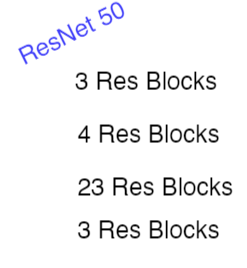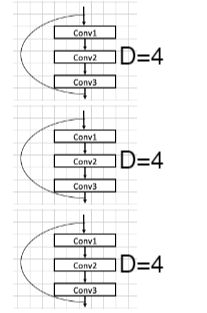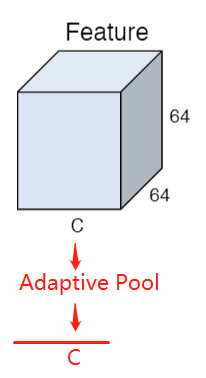DeepLab系列网络对应的文章

paper链接
v1: https://arxiv.org/abs/1412.7062
v2: https://ieeexplore.ieee.org/abstract/document/7913730/
v3:https://arxiv.org/abs/1706.05587
v3+:https://openaccess.thecvf.com/content_ECCV_2018/html/Liang-Chieh_Chen_Encoder-Decoder_with_Atrous_ECCV_2018_paper.html
DeepLab Series关键结构对比

主要改进在Backbone和Atrous Conv(实际上为Dilated Conv)上面
DeepLab V1 —— 网络结构

V1:
- backbone:VGG-16
- 各个层的连接,取了中间层的feature map
- 增加感受野的操作,Dilation
问题:Layer1-Layer4以及FC7的特征尺度不同怎么相加?
- 在Classification的第一步操作Conv(stride),通过改变stride参数,使得feature map变成同样的大小
扩展:Dilated Convlution操作

输出尺度计算公式:

dilation不同,可以cover到不同尺度的感受野
感受野越大,看的越远,但不是感受野越大越好,原因:看的太远了,和周边没关系,并且感受野越大,需要把看到的信息都记住。
DeepLab V2 —— 网络结构
 V2:
V2:
- backbone:ResNet
- ASPP(空洞卷积金字塔)模块
DeepLab V2的ASPP并没有结合前面层的模块,直接把ASPP输出的结果加起来,输出output,在V2的时候,没有将输出output做上采样操作,而是把label做下采样,使得输出和label的尺度相同,来计算loss。但现在的文章几乎没有用label下采样操作了。
其中Res Layers3、Res Layers4使用了Dilation=2,Dilation=4,举个例子,ResNet50的block如下

Res Layers4使用了Dilation=4,代表Layers4的三个block,每个block的conv都用dilation=4

问题:为什么DeepLab V2的ASPP并没有结合前面层的模块?
- ASPP模块的感受野不同,每个分支能看到更广的东西了。
ASPP模块

问题:3×3卷积之后,怎么保证输出是64×64(或者卷积过程)?
- 加上padding

DeepLab V2与PSPNet的区别
- PSPNet 用的是adaptive-pool操作
- DeepLab V2用的是dilation conv操作
DeepLab V3 —— 网络结构

ASPP模块改进版

多了2个分支(多了2个feature map):
- 1×1 Conv
- Adaptive Pool(变成1条线)

DeepLab V3 —— Multi-Grid
从 Res Layers3 开始 用不同的dilation,D逐渐增大


最终实现的DeepLab V3的框架如下:

DeepLab V3 —— Multi-Scale(Inference)
多个尺度做预测,融合起来,取平均值,再softmax,argmax
提升准确率

预测方式:
① resize:
假设Model输入是512×512,将H W resize 成 512×512,最后resize back

② Direct
③ Sliding Window + Padding
假设Model是128×128
裁剪128×128的区域,然后送进去model做分割,一堆密集的框都经过model,然后求平均值,如果H W不是128的倍数,则padding就好了。最后记得crop原来的大小。

代码:

1、deeplab.py(DeepLab V3)
import numpy as np
import paddle.fluid as fluid
from paddle.fluid.dygraph import to_variable
from paddle.fluid.dygraph import Layer
from paddle.fluid.dygraph import Conv2D
from paddle.fluid.dygraph import BatchNorm
from paddle.fluid.dygraph import Dropout
from resnet_multi_grid import ResNet50, ResNet101, ResNet152
class ASPPPooling(Layer):
# TODO: ASPPPooling :adaptive_pool + Conv1×1 + BN + ReLU + interpolate
def __init__(self, num_channels, num_filters):
super(ASPPPooling,self).__init__()
self.features = fluid.dygraph.Sequential(
Conv2D(num_channels=num_channels, num_filters=num_filters, filter_size=1),
BatchNorm(num_channels=num_filters, act='relu')
)
def forward(self, inputs):
n,c,h,w = inputs.shape
x = fluid.layers.adaptive_pool2d(inputs, (1,1))
x = self.features(x)
x = fluid.layers.interpolate(x, (h,w), align_corners=False)
return x
class ASPPConv(fluid.dygraph.Sequential):
# TODO: ASPPConv ×3 :Conv3×3 dilation + BN + ReLU
def __init__(self, num_channels, num_filters, dilation):
super(ASPPConv,self).__init__(
Conv2D(num_channels=num_channels, num_filters=num_filters, filter_size=3, padding=dilation, dilation=dilation),
BatchNorm(num_filters, act='relu')
)
class ASPPModule(Layer):
# TODO: Conv1×1、ASPPConv ×3、ASPPPooling、concat、Project
def __init__(self, num_channels, num_filters, dilation_rates):
super(ASPPModule, self).__init__()
self.features = []
# Conv1×1 + BN + ReLU
self.features.append(
fluid.dygraph.Sequential(
Conv2D(num_channels=num_channels, num_filters=num_filters, filter_size=1),
BatchNorm(num_channels=num_filters, act='relu')
)
)
# ASPPConv ×3 :Conv3×3 dilation + BN + ReLU
for r in dilation_rates:
self.features.append(
ASPPConv(num_channels, num_filters, r)
)
# ASPPPooling :adaptive_pool + Conv1×1 + BN + ReLU + interpolate
self.features.append(ASPPPooling(num_channels, num_filters))
# concat(forward写)
# Project = Conv + BN + ReLU
self.project = fluid.dygraph.Sequential( # ASPP升级模块最右边 1×1Conv C''的地方,输入为5C'
Conv2D(num_channels = num_filters*(2 + len(dilation_rates)), num_filters=num_filters, filter_size=1),
BatchNorm(num_filters, act='relu')
)
def forward(self, inputs):
res = []
for op in self.features:
res.append(op(inputs))
# concat
x = fluid.layers.concat(res, axis=1)
x = self.project(x)
return x
class DeepLabHead(fluid.dygraph.Sequential):
# TODO: ASPPModule、3x3Conv、bn、1×1Conv
def __init__(self, num_channels, num_classes):
super(DeepLabHead, self).__init__(
ASPPModule(num_channels, 256, [12, 24, 36]),
Conv2D(num_channels=256, num_filters=256, filter_size=3, padding=1),
BatchNorm(256, act='relu'),
Conv2D(256, num_classes, 1)
)
class DeepLab(Layer):
# TODO:
def __init__(self, num_classes=59):
super(DeepLab, self).__init__()
# 在resnet_multi_grid.py中已经做了dilation
resnet = ResNet50(pretrained=False)
self.layer0 = fluid.dygraph.Sequential(
resnet.conv,
resnet.pool2d_max
)
self.layer1 = resnet.layer1
self.layer2 = resnet.layer2
self.layer3 = resnet.layer3 # dilation = 2
self.layer4 = resnet.layer4 # dilation = 4
# multigrid
self.layer5 = resnet.layer5 # Res Layers4_copy1 dilation = 4,8,16
self.layer6 = resnet.layer6 # Res Layers4_copy2 dilation = 8,16,32
self.layer7 = resnet.layer7 # Res Layers4_copy3 dilation = 16,32,64
feature_dim = 2048
self.classifier = DeepLabHead(feature_dim, num_classes)
def forward(self, inputs):
n, c, h, w = inputs.shape
x = self.layer0(inputs)
x = self.layer1(x)
x = self.layer2(x)
x = self.layer3(x)
x = self.layer4(x)
x = self.layer5(x)
x = self.layer6(x)
x = self.layer7(x)
x = self.classifier(x)
x = fluid.layers.interpolate(x, (h, w), align_corners=False)
return x
def main():
with fluid.dygraph.guard():
x_data = np.random.rand(2, 3, 512, 512).astype(np.float32)
x = to_variable(x_data)
model = DeepLab(num_classes=59)
model.eval()
pred = model(x)
print(pred.shape)
if __name__ == '__main__':
main()
- resnet_multi_grid.py
import numpy as np
import paddle.fluid as fluid
from paddle.fluid.dygraph import to_variable
from paddle.fluid.dygraph import Conv2D
from paddle.fluid.dygraph import BatchNorm
from paddle.fluid.dygraph import Pool2D
from paddle.fluid.dygraph import Linear
model_path = {'ResNet18': './resnet18',
'ResNet34': './resnet34',
'ResNet50': './resnet50',
'ResNet101': './resnet101',
'ResNet152': './resnet152'}
class ConvBNLayer(fluid.dygraph.Layer):
def __init__(self,
num_channels,
num_filters,
filter_size,
stride=1,
groups=1,
act=None,
dilation=1,
padding=None,
name=None):
super(ConvBNLayer, self).__init__(name)
if padding is None:
padding = (filter_size-1)//2
else:
padding=padding
self.conv = Conv2D(num_channels=num_channels,
num_filters=num_filters,
filter_size=filter_size,
stride=stride,
padding=padding,
groups=groups,
act=None,
dilation=dilation,
bias_attr=False)
self.bn = BatchNorm(num_filters, act=act)
def forward(self, inputs):
y = self.conv(inputs)
y = self.bn(y)
return y
class BasicBlock(fluid.dygraph.Layer):
expansion = 1 # expand ratio for last conv output channel in each block
def __init__(self,
num_channels,
num_filters,
stride=1,
shortcut=True,
name=None):
super(BasicBlock, self).__init__(name)
self.conv0 = ConvBNLayer(num_channels=num_channels,
num_filters=num_filters,
filter_size=3,
stride=stride,
act='relu',
name=name)
self.conv1 = ConvBNLayer(num_channels=num_filters,
num_filters=num_filters,
filter_size=3,
act=None,
name=name)
if not shortcut:
self.short = ConvBNLayer(num_channels=num_channels,
num_filters=num_filters,
filter_size=1,
stride=stride,
act=None,
name=name)
self.shortcut = shortcut
def forward(self, inputs):
conv0 = self.conv0(inputs)
conv1 = self.conv1(conv0)
if self.shortcut:
short = inputs
else:
short = self.short(inputs)
y = fluid.layers.elementwise_add(x=short, y=conv1, act='relu')
return y
class BottleneckBlock(fluid.dygraph.Layer):
expansion = 4
def __init__(self,
num_channels,
num_filters,
stride=1,
shortcut=True,
dilation=1,
padding=None,
name=None):
super(BottleneckBlock, self).__init__(name)
self.conv0 = ConvBNLayer(num_channels=num_channels,
num_filters=num_filters,
filter_size=1,
act='relu')
# name=name)
self.conv1 = ConvBNLayer(num_channels=num_filters,
num_filters=num_filters,
filter_size=3,
stride=stride,
padding=padding,
act='relu',
dilation=dilation)
# name=name)
self.conv2 = ConvBNLayer(num_channels=num_filters,
num_filters=num_filters * 4,
filter_size=1,
stride=1)
# name=name)
if not shortcut:
self.short = ConvBNLayer(num_channels=num_channels,
num_filters=num_filters * 4,
filter_size=1,
stride=stride)
# name=name)
self.shortcut = shortcut
self.num_channel_out = num_filters * 4
def forward(self, inputs):
conv0 = self.conv0(inputs)
#print('conv0 shape=',conv0.shape)
conv1 = self.conv1(conv0)
#print('conv1 shape=', conv1.shape)
conv2 = self.conv2(conv1)
#print('conv2 shape=', conv2.shape)
if self.shortcut:
short = inputs
else:
short = self.short(inputs)
#print('short shape=', short.shape)
y = fluid.layers.elementwise_add(x=short, y=conv2, act='relu')
return y
class ResNet(fluid.dygraph.Layer):
def __init__(self, layers=50, num_classes=1000, multi_grid=[1, 2, 4], duplicate_blocks=False):
super(ResNet, self).__init__()
self.layers = layers
supported_layers = [18, 34, 50, 101, 152]
assert layers in supported_layers
mgr = [1, 2, 4] # multi grid rate for duplicated blocks
if layers == 18:
depth = [2, 2, 2, 2]
elif layers == 34:
depth = [3, 4, 6, 3]
elif layers == 50:
depth = [3, 4, 6, 3]
elif layers == 101:
depth = [3, 4, 23, 3]
elif layers == 152:
depth = [3, 8, 36, 3]
if layers < 50:
num_channels = [64, 64, 128, 256, 512]
else:
num_channels = [64, 256, 512, 1024, 2048]
num_filters = [64, 128, 256, 512]
self.conv = ConvBNLayer(num_channels=3,
num_filters=64,
filter_size=7,
stride=2,
act='relu')
self.pool2d_max = Pool2D(pool_size=3,
pool_stride=2,
pool_padding=1,
pool_type='max')
if layers < 50:
block = BasicBlock
l1_shortcut=True
else:
block = BottleneckBlock
l1_shortcut=False
self.layer1 = fluid.dygraph.Sequential(
*self.make_layer(block,
num_channels[0],
num_filters[0],
depth[0],
stride=1,
shortcut=l1_shortcut,
name='layer1'))
self.layer2 = fluid.dygraph.Sequential(
*self.make_layer(block,
num_channels[1],
num_filters[1],
depth[1],
stride=2,
name='layer2'))
self.layer3 = fluid.dygraph.Sequential(
*self.make_layer(block,
num_channels[2],
num_filters[2],
depth[2],
stride=1,
dilation=2,
name='layer3'))
# add multi grid [1, 2, 4]
self.layer4 = fluid.dygraph.Sequential(
*self.make_layer(block,
num_channels[3],
num_filters[3],
depth[3],
stride=1,
name='layer4',
dilation=multi_grid))
# if duplicate_blocks:
self.layer5 = fluid.dygraph.Sequential(
*self.make_layer(block,
num_channels[4],
num_filters[3],
depth[3],
stride=1,
name='layer5',
dilation=[x*mgr[0] for x in multi_grid]))
self.layer6 = fluid.dygraph.Sequential(
*self.make_layer(block,
num_channels[4],
num_filters[3],
depth[3],
stride=1,
name='layer6',
dilation=[x*mgr[1] for x in multi_grid]))
self.layer7 = fluid.dygraph.Sequential(
*self.make_layer(block,
num_channels[4],
num_filters[3],
depth[3],
stride=1,
name='layer7',
dilation=[x*mgr[2] for x in multi_grid]))
self.last_pool = Pool2D(pool_size=7, # ignore if global_pooling is True
global_pooling=True,
pool_type='avg')
self.fc = Linear(input_dim=num_filters[-1] * block.expansion,
output_dim=num_classes,
act=None)
self.out_dim = num_filters[-1] * block.expansion
def forward(self, inputs):
x = self.conv(inputs)
x = self.pool2d_max(x)
#print(x.shape)
x = self.layer1(x)
#print(x.shape)
x = self.layer2(x)
#print(x.shape)
x = self.layer3(x)
#print(x.shape)
x = self.layer4(x)
#print(x.shape)
x = self.last_pool(x)
x = fluid.layers.reshape(x, shape=[-1, self.out_dim])
x = self.fc(x)
return x
def make_layer(self, block, num_channels, num_filters, depth, stride, dilation=1, shortcut=False, name=None):
layers = []
if isinstance(dilation, int):
dilation = [dilation] * depth
elif isinstance(dilation, (list, tuple)):
assert len(dilation) == 3, "Wrong dilation rate for multi-grid | len should be 3"
assert depth ==3, "multi-grid can only applied to blocks with depth 3"
padding = []
for di in dilation:
if di>1:
padding.append(di)
else:
padding.append(None)
layers.append(block(num_channels,
num_filters,
stride=stride,
shortcut=shortcut,
dilation=dilation[0],
padding=padding[0],
name=f'{name}.0'))
for i in range(1, depth):
layers.append(block(num_filters * block.expansion,
num_filters,
stride=1,
dilation=dilation[i],
padding=padding[i],
name=f'{name}.{i}'))
return layers
def ResNet18(pretrained=False):
model = ResNet(layers=18)
if pretrained:
model_state, _ = fluid.load_dygraph(model_path['ResNet18'])
model.set_dict(model_state)
return model
def ResNet34(pretrained=False):
model = ResNet(layers=34)
if pretrained:
model_state, _ = fluid.load_dygraph(model_path['ResNet34'])
model.set_dict(model_state)
return model
def ResNet50(pretrained=False, duplicate_blocks=False):
model = ResNet(layers=50, duplicate_blocks=duplicate_blocks)
if pretrained:
model_state, _ = fluid.load_dygraph(model_path['ResNet50'])
if duplicate_blocks:
set_dict_ignore_duplicates(model, model_state)
else:
model.set_dict(model_state)
return model
def findParams(model_state, name):
new_dict = dict()
for key,val in model_state.items():
if name == key[0:len(name)]:
print(f'change {key} -> {key[len(name)+1::]}')
new_dict[key[len(name)+1::]] = val
return new_dict
def set_dict_ignore_duplicates(model, model_state):
model.conv.set_dict(findParams(model_state,'conv'))
model.pool2d_max.set_dict(findParams(model_state,'pool2d_max'))
model.layer1.set_dict(findParams(model_state,'layer1'))
model.layer2.set_dict(findParams(model_state,'layer2'))
model.layer3.set_dict(findParams(model_state,'layer3'))
model.layer4.set_dict(findParams(model_state,'layer4'))
model.fc.set_dict(findParams(model_state,'fc'))
return model
def ResNet101(pretrained=False, duplicate_blocks=False):
model = ResNet(layers=101, duplicate_blocks=duplicate_blocks)
if pretrained:
model_state, _ = fluid.load_dygraph(model_path['ResNet101'])
if duplicate_blocks:
set_dict_ignore_duplicates(model, model_state)
else:
model.set_dict(model_state)
return model
def ResNet152(pretrained=False):
model = ResNet(layers=152)
if pretrained:
model_state, _ = fluid.load_dygraph(model_path['ResNet152'])
model.set_dict(model_state)
return model
def main():
with fluid.dygraph.guard():
#x_data = np.random.rand(2, 3, 512, 512).astype(np.float32)
x_data = np.random.rand(2, 3, 224, 224).astype(np.float32)
x = to_variable(x_data)
#model = ResNet18()
#model.eval()
#pred = model(x)
#print('resnet18: pred.shape = ', pred.shape)
#model = ResNet34()
#pred = model(x)
#model.eval()
#print('resnet34: pred.shape = ', pred.shape)
model = ResNet101(pretrained=False)
model.eval()
pred = model(x)
print('dilated resnet50: pred.shape = ', pred.shape)
#model = ResNet101()
#pred = model(x)
#model.eval()
#print('resnet101: pred.shape = ', pred.shape)
#model = ResNet152()
#pred = model(x)
#model.eval()
#print('resnet152: pred.shape = ', pred.shape)
#print(model.sublayers())
#for name, sub in model.named_sublayers(include_sublayers=True):
# #print(sub.full_name())
# if (len(sub.named_sublayers()))
# print(name)
if __name__ == "__main__":
main()






















 5583
5583











 被折叠的 条评论
为什么被折叠?
被折叠的 条评论
为什么被折叠?








